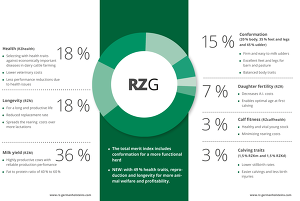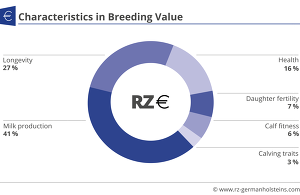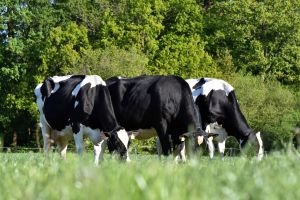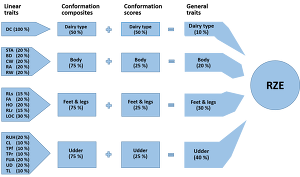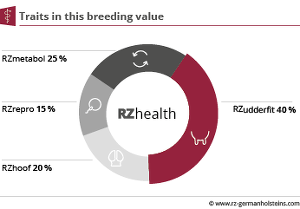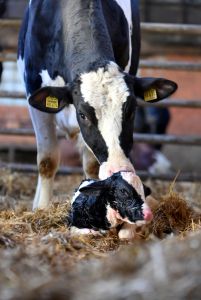Breeding value estimation
Germany has a leading role in the estimation of breeding values. This applies to the total breeding value RZG as well as to the traits taken into account and the estimation methods used. The great quantity and the high quality of the data contributes in a significant way to breeding values with a high degree of reliability. The independent data centre Vereinigte Informationssysteme Tierhaltung w. V. (vit) estimates the breeding values on a genomic basis for the entire German Holstein breed according to latest scientific knowledge and under the control of state supervisory authorities. The milk recording is carried out by independently operating organisations. Only in some traits the breeding organisations support the data collection. The collection of health information, on the other hand, is sent directly from KuhVision farms and contract herds to the vit.
In total, more than 50 individual breeding values are now available to breeders. Many of these individual breeding values are combined into an index, such as the RZG or the total economic breeding value RZ€. They are issued for all animals. A little more special is the index RZRobot. This index only identifies bulls that are well-suited sires for automatically milked cows due to the traits they inherit.
Breeding values are estimated for all economically important trait complexes:
- milk production (milk yield, fat, protein)
- somatic cell count
- longevity
- conformation (19 linear traits, 4 trait complexes)
- health (mastitis, metabolic diseases, claw diseases and reproductive disorders)
- Fertility (female and male fertility)
- calving traits (maternal and direct calving)
- calf vitality and health
- milking speed and milking temperament
Most of the traits are estimated with a BLUP animal model, taking into account all relationships, for the entire German Holstein breed on the basis of the animals registered in the German herdbook (more than 50 million).
In the meantime, the genomic breeding value estimation takes place weekly and thus offers farmers extensive opportunities for their herd management. All official breeding values are updated during the main evaluation releases in April, August and December.
New developments and further information on the breeding value estimation can be found here.
Breeding values
To ensure complete and nationwide comparability of the breeding values of bulls and cows, the data centre vit has been commissioned to carry out a joint, nationwide breeding value estimation for the breeds Holstein, Red Cattle (Angler), Jersey, Red & White dual purpose (RDN) and German Black & White dual purpose (DSN). In addition, the vit ensures optimal data processing and online networking
of all Holstein breeding organisations.
Reliability of the breeding values
The calculation of the reliability of the breeding values is carried out in the random regression model with the 'Effective Daughter Contribution' method extended to the multi-trait model (Liu et al., 2001a). This method takes into account not only the amount of information about the animal to be estimated and its relatives, but also the number and distribution of reference animals.
Basis of the breeding values
The basis for the RZ€, the natural milk yield breeding values (+/-0 kg) and the relative breeding values (100) are all 4-6 year old cows (for 2021: cows born 2015-2017). This basis is standardised for the relative breeding values to a mean value of 100 and a genetic dispersion of 12 points. Each April, the basis is shifted by one birth cohort for the breeding value estimation.
The total merit index RZG
The German Holstein Association defined an total merit index (RZG) as early as 1997, which includes all economically important traits of the breeding objective. The RZG is adapted to changing economic and social requirements at irregular intervals. The last adjustment of the total breeding value was made in April 2021. The RZG has a high international standing and is close behind the American TPI in its importance. More information here.
The estimated breeding values for numerous individual traits are first combined into relative breeding values within trait complexes. The most important relative breeding values are then included in the RZG.
The economic net merit index RZ€
The RZ€ was introduced in August 2020 as a new total breeding value alongside the RZG. In contrast to the RZG, however, this index is not shown on a relative scale but as a marginal gain in Euro. As a purely economically defined breeding value, it reflects the economic potential of an animal compared to the population mean within an average life span of a cow (corresponds to about 3 lactations). The economic derivation was made on the basis of farm evaluations of the Chamber of Agriculture and scientific publications. The complexes milk production, longevity and health are of particular importance. Since the marginal costs/profit will change over time, a periodic reweighting of this index is planned.
Milk production (RZM) and somatic cell score (RZS)
Germany was the first Holstein country to introduce a test day model for milk production traits as early as 1996. Since 2003, the breeding value estimation in vit (data center Verden) has been calculated with a multi-lactation random regression animal model (RRM) on the basis of test day results.
From the milk recording database, individual test results of lactations 1 to 3 since 01/01/2000 are included in the breeding value estimation. The officially valid test results (plausibility check by the milk recording) must fulfil the following conditions in order to be taken into account in the breeding value estimation:
- Age at calving: 20 to 40, 30 to 56 and 44 to 75 months for lactations 1, 2 and 3.
- Test day: 5th to 330th day of lactation
- Complete pedigree information for two generations of ancestors.
The breeding value estimation is carried out with a random regression model, which is characterised by the use of test day results instead of lactation performance. This allows environmental effects to be taken into account via the herd test day and a correlation to be made via the lactation stage. All test day results from a lactation are taken as repeated observations of a trait. The multi-lactation approach is maintained, i.e. the lactations are treated as different, genetically determined traits. The inclusion of the milk recording from lactations 1 to 3 is chosen in order to ensure the best possible agreement with the breeding objective of a cow with a high lifetime production.
Relative breeding value milk production (RZM)
The RZM is an index consisting of the individual breeding values for fat yield (in kg) and protein yield (in kg) in breed-specific weighting. The ratio for fat yield to protein yield is 1:2. The milk yield is not taken into account directly. However, it is indirectly influenced by the amount of fat and protein.
Somatic cell score (RZS)
In Germany the somatic cell count is determined at every milk recording and converted into the logarithmic cell score (SCS) for the breeding value estimation. An increased cell count as an expression of acute and chronic mastitis occurs more frequently in higher lactations and with a greater genetic variation between animals. Therefore, the values from the 2nd and 3rd lactation are given a higher weight (37% each) than the breeding values from the first lactation (26%). The scale of the relative breeding value somatic cell score (RZS) is chosen in such a way that animals that inherit a high cell count, which is undesirable from a breeding point of view, receive breeding values below 100.
In the meantime, a direct breeding value for the improvement of udder health is also available in the form of RZudderfit.
Functional herd life (RZN)
The trait herd life indirectly describes the health and constitution of a cow. Due to the high importance of a good longevity for the profitability of milk production, it has the second highest weighting (18 %) in the overall breeding value. The vit has been carrying out a breeding value estimation for the functional herd life since 1996.
With regard to the longevity, a distinction should be made between a voluntary and an involuntary culling of the animal. Involuntary cullings are those that are necessary, for example, due to a lack of fitness of the animals. Voluntary cullings are often strongly influenced by the milk yield of the cows. To ensure that the better treatment of high-yielding animals (e.g. more insemination attempts, more intensive/longer treatment in case of illness) does not lead to a distortion of the herd life breeding values, the trait is defined as functional herd life. This means that a correction is made for the different treatment based on the performance superiority or inferiority within the herd.
Until 2018, a survival analysis was used to estimate herd life breeding values. The disadvantage of this method was a relatively low reliability, which could be improved with the help of secondary traits (e.g. cell score, various conformation traits). Since April 2018, a new method has been used that no longer requires secondary traits. In this method, survival (yes/no) is considered in each of three lactation stages of the first three lactations. These nine life stages have been divided based on the distribution of frequent reasons for culling, as different reasons for culling occur in each stage. Due to high genetic correlations to higher lactations, breeding values are only estimated for the first three lactations. The significantly increased calculation effort for a higher number of lactations would only be accompanied by a small gain in reliability. The nine individual heritabilities result in a cumulative heritability of 9%. The 9 partial breeding values are combined to a breeding value RZN. Overall, this model better predicts the herd life.
Conformation/Type (RZE)
The data for the conformation breeding value estimation are based on the linear description and evaluation of cows in the first lactation. Thereby, 19 traits are described on a scale from 1 to 9. The daughters of A.I. bulls are selected randomly and independently from the vit data centre. In herd genotyping and contract herds, as far as possible, all first-lactating cows are described linearly. Out of approx. 4.6 million cows, about 2.4 million linearly described Holstein/Red Holstein cows were taken into account in the breeding value estimation in 2021. The minimum requirements for data quality apply (sire, dam and dam's sire must be known).
The breeding value estimation for the 19 linear traits is carried out as a multi-trait model within the four trait composites dairy type, body, feet & legs and udder. In this way, the genetic relationships between the traits can be used as an additional source of information and the reliability of the breeding values for the individual traits increases. The relative breeding value conformation (RZE) results from the combination of the four breeding values for the individual traits of dairy type, body, feet & legs and udder in a ratio of 10 : 20 : 30 : 40.
Health (RZhealth)
The health breeding values are published since April 2019 and enable more targeted breeding for improved animal health.
The data results from on-farm records on animal health (documented by veterinarian, hoof trimmer, farmer and employee) and are collected in a large-scale project in Germany, Luxembourg and Austria. Birth-related observations reported to HITier (mastitis, postpartum problems and lameness) are also taken into account in the evaluations. For good data quality, realistic frequencies/incidences must be achieved at farm level in the different trait complexes. In order to realise a uniformity of the data, they are recorded by using a standard diagnosis key (according to ADR recommendation). Breeding values for udder health (RZudderfit), hoof health (RZhoof), reproductive tract health (RZrepro), metabolic health (RZmetabol), calf fitness (RZcalffit) and dermatitis digitalis (DDcontrol) are published. RZhealth combines the first four mentioned breeding values into one index and can thus be used for pre-selection.
Daughter fertility (RZR)
The breeding value estimation for daughter fertility is based on the data of all artificial and natural inseminations. The magnitude and completeness of this data base is unique in the world. In a multi-trait model, breeding values are estimated for five different traits of female fertility from the complexes calving to 1st mating and conception. The four breeding values from the conception complex (Non-Return-Rate-56 for heifers and cows and First-to-Last for heifers and cows) are combined to the index conception
. Together with the breeding value for calving to 1st mating as trait for the beginning of the cycle they form the relative breeding value daughter fertility RZR (R = reproduction) with a weighting of 90% conception traits to 10% calving to 1st mating. Daughter fertility is weighted with 7% in the RZG.
Calving traits (RZKm and RZKd)
The data basis for the calving breeding values is the information given at birth notification. They include the calving ease and information on the survival of the calf in the first 48 hours. The calving ease is recorded subjectively by the farmer in four levels (from easy to veterinary assistance/operation).
As an important component of the calving traits, stillbirths are included in the breeding values. In addition to stillborn calves, calves that die within the first 48 hours are also counted as stillborn calves. The trait stillbirths is only partially linked to calving ease and must therefore be considered as a separate trait.
The information on calving ease forms the second partial breeding value of the calving index (RZK). Since the variance in this trait is smaller than in the trait stillbirths, this partial breeding value receives a smaller weight in the calving Index.
For the calving traits, both the influence of the calf (direct), e.g. by body shape and size, and the influence of the cow (maternal), e.g. by size and shape of the rump, are estimated. The inclusion of both breeding values (RZKm and RZKd) in the selection process is important because they are genetically negatively correlated.
Calving problems occur mainly at first calving. The selection of bulls according to calving progress is therefore primarily decisive when mating with heifers. For this reason, the breeding value is published for first calvings and gets its high certainties by considering the correlations to higher lactations.
Calf fitness/survival (RZcalffit)
The RZcalffit describes the genetically determined ability to survive the rearing period from day 2 to the age of 15 months. Similar to the longevity of cows, different diseases are responsible for the losses of young animals in the different stages of life. Therefore, 5 age periods are considered in the estimation model (day 3-14, 15-60, 61-120, 121-200, 201-458). The heritability is not particularly high at just under 2 %, but the genetic standard deviation is substantial at ±3 % losses. The data basis is large and thus the reliability is good. The genomic RZcalffit has a reliability of 51 %.
The data is based on the mandatory registration and traceability data for all cattle. All losses due to death
or killing
for young female calves born since 2006 are recorded and can therefore be used in the breeding value estimation. A total of approx. 8 million female calves are included in the breeding value estimation. Male calves are not informative, as they usually leave the farm when they are about 14 days old. The breeding value RZcalffit is expressed on the usual scale with 100 as average and a standard deviation of 12. High values lead to fewer calf losses. The average of 100 corresponds to about 93% of surviving animals up to 15 mo., with 60% of young calf losses occurring in the first two age intervals up to 60 days.
Futher breeding values
In addition to the presented breeding values, breeding values for milking speed, temperament and body condition score are estimated. The data for milking speed (RZD) is collected from herds with a measuring tool for milk flow. Temperament as behaviour during milking (MVH) and body condition score (BCS) are derived from the owner survey and the conformation classification of first lactation cows.
Suitability for robotic milking (RZRobot)
Dairy farmers milking with an Automatic Milking System (AMS) prefer cows with good udder traits in shape, teat length and teat placement. Milking ability, milking behaviour, cell count and mobility of the cows also play a very important role in the efficiency of the AMS.
The RZRobot provides herdsman of an AMS farm with a useful tool for bull selection. The RZRobot combines the traits that are of great importance in the bull selection of many AMS farms into an index and weights the traits in a reasonable way. Exclusion criteria have been defined for the traits milkability, rear teat placement and teat length. If a bull does not meet the minimum requirements in these traits, it is not suitable for use in AMS farms and no RZRobot is shown.
| Merkmal | relatives Gewicht | Mindestanforderung |
| Milking Speed (RZD) | 20 % | ≥ 94 |
| Somatic Cell Score (RZS) | 15 % | |
| Feet & Legs | 15 % | |
| Rear Teat Placement (negativ gewichtet) | 20 % | ≤ 106 |
| Teat Length | 20 % | |
| Udder | 10 % | ≥ 94 |
| RZRobot | 100 % | ≥ 100 |
For further information on the breeding value estimation and the breeding values, please refer to the description of the breeding value estimation from vit.

